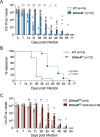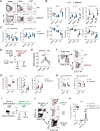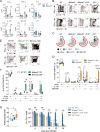This is a preprint.
BHLHE40 drives protective polyfunctional CD4 T cell differentiation in the female reproductive tract against Chlamydia
- PMID: 37961221
- PMCID: PMC10635079
- DOI: 10.1101/2023.11.02.565369
BHLHE40 drives protective polyfunctional CD4 T cell differentiation in the female reproductive tract against Chlamydia
Update in
-
BHLHE40 drives protective polyfunctional CD4 T cell differentiation in the female reproductive tract against Chlamydia.PLoS Pathog. 2024 Jan 25;20(1):e1011983. doi: 10.1371/journal.ppat.1011983. eCollection 2024 Jan. PLoS Pathog. 2024. PMID: 38271477 Free PMC article.
Abstract
The protein basic helix-loop-helix family member e40 (BHLHE40) is a transcription factor recently emerged as a key regulator of host immunity to infections, autoimmune diseases and cancer. In this study, we investigated the role of Bhlhe40 in protective T cell responses to the intracellular bacterium Chlamydia in the female reproductive tract (FRT). Mice deficient in Bhlhe40 exhibited severe defects in their ability to control Chlamydia muridarum shedding from the FRT. The heightened bacterial burdens in Bhlhe40-/- mice correlated with a marked increase in IL-10-producing T regulatory type 1 (Tr1) cells and decreased polyfunctional CD4 T cells co-producing IFN-γ, IL-17A and GM-CSF. Genetic ablation of IL-10 or functional blockade of IL-10R increased CD4 T cell polyfunctionality and partially rescued the defects in bacterial control in Bhlhe40-/- mice. Using single-cell RNA sequencing coupled with TCR profiling, we detected a significant enrichment of stem-like T cell signatures in Bhlhe40-deficient CD4 T cells, whereas WT CD4 T cells were further down on the differentiation trajectory with distinct effector functions beyond IFN-γ production by Th1 cells. Altogether, we identified Bhlhe40 as a key molecular driver of CD4 T cell differentiation and polyfunctional responses in the FRT against Chlamydia.
Keywords: Bhlhe40; Chlamydia; female reproductive tract; polyfunctional CD4 T cells.
Figures






References
-
- Andrew D.W., Cochrane M., Schripsema J.H., Ramsey K.H., Dando S.J., O’Meara C.P., Timms P., and Beagley K.W.. 2013. The Duration of Chlamydia muridarum Genital Tract Infection and Associated Chronic Pathological Changes Are Reduced in IL-17 Knockout Mice but Protection Is Not Increased Further by Immunization. PLOS ONE. 8:e76664. doi:10.1371/journal.pone.0076664. - DOI - PMC - PubMed
-
- Bakshi R.K., Gupta K., Jordan S.J., Chi X., Lensing S.Y., Press C.G., and Geisler W.M.. 2018. An Adaptive Chlamydia trachomatis-Specific IFN-γ-Producing CD4+ T Cell Response Is Associated With Protection Against Chlamydia Reinfection in Women. Front. Immunol. 9. doi:10.3389/fimmu.2018.01981. - DOI - PMC - PubMed
-
- Brockmann L., Gagliani N., Steglich B., Giannou A.D., Kempski J., Pelczar P., Geffken M., Mfarrej B., Huber F., Herkel J., Wan Y.Y., Esplugues E., Battaglia M., Krebs C.F., Flavell R.A., and Huber S.. 2017. IL-10 Receptor Signaling Is Essential for TR1 Cell Function In Vivo. The Journal of Immunology. 198:1130–1141. doi:10.4049/jimmunol.1601045. - DOI - PMC - PubMed
Publication types
Grants and funding
LinkOut - more resources
Full Text Sources
Research Materials
